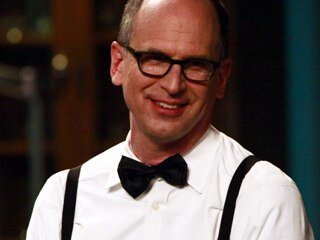Breaking Point
James Oseland realizes he's a nerd.

If you couldn’t tell by the suspenders and bow tie I sported for this week’s episode, it turns out that I’m a nerd. I’m genuinely, deeply interested in the biological and chemical processes that we engage with whenever we cook or eat. When I cook at home, I dissect everything; even when I cook things that I think are good, I like to pay attention to what exactly it was that made them so great, whether it was a balance between acid and fat in a stew, or the effects that the ambient temperature in the kitchen that day had on the final result. Early in this week’s episode, Curtis told the cheftestants that cooking was a lot like science; the fact is, cooking is science. As this episode drove home, even the simple act of making a dough or searing a steak is chemistry and physics in action. It was pretty ironic when Hugh’s assistant this week told him he wasn’t a scientist; he certainly is — it’s just a matter of semantics.
Given my predisposition for the geekier side of food, I had a blast participating in this week’s episode. Ruth and I were like kids in a candy shop wandering around the Top Chef Masters Edible Science Fair—maybe we had too much fun, since the producers kept shooing us away from the cheftestants’ demos because we were spending so much time asking questions and marveling at science in action! I was deeply impressed by (almost) all of the cheftestants’ commitment to this week’s intellectually rigorous challenge; I walked away from most of their demos having learned things I’d never known before, and also appreciating the depth to which the chefs had rethought techniques and properties that they’d been working with for years.
Mary Sue’s demonstration on viscosity was the perfect encapsulation of everything we were looking for in this challenge. Every chef knows that some liquids are thicker and slower moving than others, and that this variance in texture can have a meaningful effect on a final dish. But at her table, Mary Sue delivered an impassioned, engaging, lucid demonstration of the differences between dulce de leche and cream—as well as why they’re different. It didn’t hurt that her dulce de leche churro was utterly spectacular; it was a bite of food good enough to win any Elimination Challenge. Poor Floyd is clearly getting tired of always coming in second to Mary Sue. His exquisite (petri) dish of beef two ways was just as delicious as that churro, but Mary Sue really nailed the challenge on the strength of her natural teaching style and the strong visuals of her demo.
While Naomi and Traci both served marvelous food, both suffered slightly. Traci’s demonstration of the effects of acid on food was executed well, but she took a too-obvious route with her ingredients, going straight to lemon juice and its visually arresting ability to rapidly denature the proteins in seafood. (Her plate of tuna two ways was, however, impeccable — the shaved artichoke had a beautiful, woody flavor against the bright citrus.) Naomi may have served a pizza pocket, but it was certainly the tastiest pizza pocket I’ve ever had, even taking into account the unfortunate inclusion of gelée in her mini-calzones, which melted immediately and turned her carefully prepared dough into a gooey mess. Unfortunately, her demonstration of elasticity put a little too much burden on the audience: Instead of fully explaining elasticity and what it means for flavor and mouthfeel, Naomi relied on touchable props. Very fun to poke and prod, but they were insufficient to really express this scientific concept.
These four dishes were all marvelous; even with the limitations placed on the chefs’ equipment, they rank among the tastiest I’ve tried all season. Hugh’s fried okra salad, however, was another matter entirely. It was, quite simply, a wan dish, one that conveyed his concept of “emulsion” almost as an afterthought. Even if the herb mayonnaise on my portion hadn’t been broken (sorry — it was, it really was), it still would have been an underwhelming demonstration of the concept. Hugh was not having a good day — in fact, I think he hadn’t been having a good couple of episodes. Bright, effervescent, talented Hugh had been fading; he’d become, just as he’d insinuated that he might in Episode 1, the Black Swan. It was, sadly, time for him to go home.
James Oseland is the editor-in-chief of Saveur magazine.



